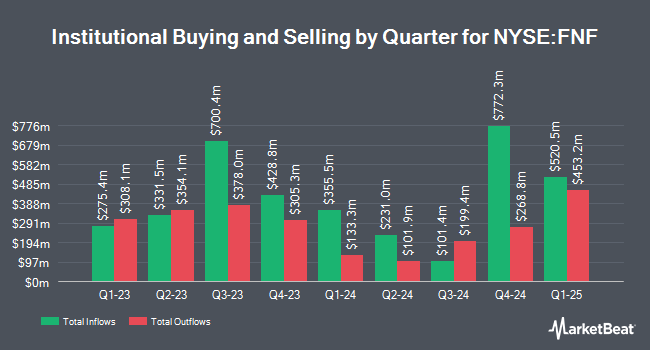Bank of Montreal Can decreased its position in shares of Fidelity National Financial, Inc. (NYSE:FNF - Free Report) by 2.9% during the 4th quarter, according to the company in its most recent 13F filing with the Securities and Exchange Commission. The fund owned 178,929 shares of the financial services provider's stock after selling 5,278 shares during the quarter. Bank of Montreal Can owned approximately 0.07% of Fidelity National Financial worth $10,045,000 as of its most recent filing with the Securities and Exchange Commission.
A number of other hedge funds have also recently modified their holdings of FNF. Orion Portfolio Solutions LLC raised its position in Fidelity National Financial by 30.9% in the third quarter. Orion Portfolio Solutions LLC now owns 11,780 shares of the financial services provider's stock valued at $731,000 after purchasing an additional 2,782 shares during the period. Barclays PLC increased its position in shares of Fidelity National Financial by 4.4% during the 3rd quarter. Barclays PLC now owns 216,755 shares of the financial services provider's stock worth $13,451,000 after purchasing an additional 9,146 shares during the last quarter. Geode Capital Management LLC raised its holdings in Fidelity National Financial by 1.6% in the 3rd quarter. Geode Capital Management LLC now owns 4,462,837 shares of the financial services provider's stock valued at $276,343,000 after buying an additional 69,643 shares during the period. Sunbelt Securities Inc. lifted its position in Fidelity National Financial by 867.7% in the third quarter. Sunbelt Securities Inc. now owns 1,287 shares of the financial services provider's stock valued at $80,000 after buying an additional 1,154 shares during the last quarter. Finally, Wilmington Savings Fund Society FSB purchased a new position in Fidelity National Financial during the third quarter worth about $672,000. Hedge funds and other institutional investors own 81.17% of the company's stock.
Analyst Ratings Changes
Several equities analysts have recently commented on FNF shares. Keefe, Bruyette & Woods upgraded shares of Fidelity National Financial from a "market perform" rating to an "outperform" rating and set a $69.00 price objective on the stock in a report on Tuesday, April 8th. Barclays boosted their price objective on Fidelity National Financial from $61.00 to $67.00 and gave the company an "equal weight" rating in a report on Monday, February 24th. Stephens lifted their target price on Fidelity National Financial from $68.00 to $75.00 and gave the company an "overweight" rating in a research report on Monday, February 24th. Deutsche Bank Aktiengesellschaft raised shares of Fidelity National Financial from a "hold" rating to a "buy" rating and increased their price target for the stock from $76.00 to $77.00 in a research report on Friday, January 3rd. Finally, StockNews.com downgraded shares of Fidelity National Financial from a "buy" rating to a "hold" rating in a research note on Tuesday, March 4th. Two analysts have rated the stock with a hold rating and four have issued a buy rating to the stock. According to data from MarketBeat.com, the stock has a consensus rating of "Moderate Buy" and an average target price of $71.60.
Check Out Our Latest Report on FNF
Fidelity National Financial Stock Up 0.4 %
Shares of Fidelity National Financial stock traded up $0.27 on Friday, reaching $61.75. 5,166,755 shares of the company were exchanged, compared to its average volume of 1,112,935. The stock's 50 day moving average price is $61.87 and its 200-day moving average price is $60.20. The company has a market cap of $16.98 billion, a P/E ratio of 13.28 and a beta of 1.09. Fidelity National Financial, Inc. has a 1-year low of $47.20 and a 1-year high of $66.72. The company has a debt-to-equity ratio of 0.47, a current ratio of 0.24 and a quick ratio of 0.24.
Fidelity National Financial (NYSE:FNF - Get Free Report) last posted its quarterly earnings results on Thursday, February 20th. The financial services provider reported $1.34 EPS for the quarter, topping the consensus estimate of $1.23 by $0.11. Fidelity National Financial had a net margin of 9.28% and a return on equity of 15.36%. The company had revenue of $3.62 billion during the quarter, compared to analysts' expectations of $3.33 billion. During the same quarter in the previous year, the business posted $0.75 EPS. As a group, equities analysts forecast that Fidelity National Financial, Inc. will post 6.28 EPS for the current year.
Fidelity National Financial Announces Dividend
The firm also recently disclosed a quarterly dividend, which was paid on Monday, March 31st. Stockholders of record on Monday, March 17th were given a dividend of $0.50 per share. The ex-dividend date of this dividend was Monday, March 17th. This represents a $2.00 annualized dividend and a dividend yield of 3.24%. Fidelity National Financial's dividend payout ratio is currently 43.01%.
About Fidelity National Financial
(
Free Report)
Fidelity National Financial, Inc, together with its subsidiaries, provides various insurance products in the United States. The company operates through Title, F&G, and Corporate and Other segments. It offers title insurance, escrow, and other title related services, including trust activities, trustee sales guarantees, recordings and reconveyances, and home warranty products.
Further Reading

Before you consider Fidelity National Financial, you'll want to hear this.
MarketBeat keeps track of Wall Street's top-rated and best performing research analysts and the stocks they recommend to their clients on a daily basis. MarketBeat has identified the five stocks that top analysts are quietly whispering to their clients to buy now before the broader market catches on... and Fidelity National Financial wasn't on the list.
While Fidelity National Financial currently has a Moderate Buy rating among analysts, top-rated analysts believe these five stocks are better buys.
View The Five Stocks Here
Discover the 10 Best High-Yield Dividend Stocks for 2025 and secure reliable income in uncertain markets. Download the report now to identify top dividend payers and avoid common yield traps.
Get This Free Report
Like this article? Share it with a colleague.
Link copied to clipboard.